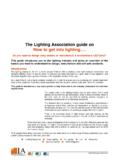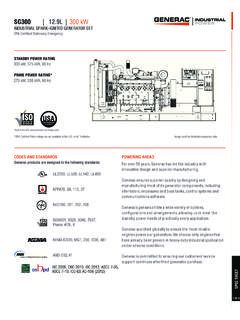Transcription of Exothermic chemical processes rely on efficient control of ...
1 Exothermic chemical processes rely on efficient control of temperature and pressure to prevent the phenomenon of runaway reaction (thermal runaway) when mixing chemicals in a reactor. Outline the methods used to control temperature and pressure in such circumstances. (10) Exothermic = gives out heat energy Endothermic = takes in heat energy High integrity temp detection Pressure rise detection linked to cooling, venting, auto-shutdown External cooling chilled water jacketing Air cooled heat exchangers Pre-chilling of reactant before mixing Limiting rates of addition to within safe thresholds Maintenance ensure clean, efficient vessels, maint programme, regular internal cleaning to prevent build up, Location away from other heat soucres. (a) In relation to automatic fire detection and alarm systems, outline the basic principles of operation of: (i) heat detectors; (4) (ii) smoke detectors. (4) (b) Identify the circumstances in which EACH type of detector would be inappropriate.
2 (2) Rate of rise heat detector Responds to rapid increase in temperature, electronic resistors Use where smoke detector is undesirable flammable liquids Fixed temperature heat detector Sensing element at fixed temperature, set at pre-determined temperature uses a thermocouple. Triggers alarm Kitchens or boiler rooms rate of rise no good Ionisation SMOKE Detectors Smoke particles pass between 2 electrodes Causes ionisation of surrounding air and a small current flow Added weight of smoke particles slows down transmission rate, alarm triggered Fast faming fires, small particles of smoke False alarms from burning odours Optical smoke detectors IR light refracting off smoke particles entering detection chamber, onto a light sensor which triggers alarm Good for large particles of smoke Smouldering fires, fabrics, furnishings Prone to false alarms caused by steam or dusty environments (a) Outline the principles of gamma radiography.
3 (3) (b) Outline the advantages and disadvantages of gamma radiography as a form of non-destructive testing. (7) Transmission of Gamma rays from sealed ionising radiation source Through test object onto film placed on opposite side Film records intensity of radiation received Cracks and flaws = hollow = less radiation absorbed, defects shown as darker areas on film Advantages Detects internal defects Permanent record Wide range of materials Does not require power source Disadvantages Requires full compliance with IRR Requires large exclusion zone Access required both sides of test piece Special shielded bays Time consuming Expensive Results not instant Need for competence Detailed SSOW required to control hazards exposure to employees / other persons Aircrafts Pressure vessels Bridge girders Pipes The Lifting Operations and Lifting Equipment Regulations 1998 specifiy fixed intervals between thorough examinations of lifting equipment but also includes an option for thorough examination to be carried out in accordance with an examination scheme.
4 Outline the factors that a competent person would need to take into account when deciding whether less frequent examinations might be justified. (10) Age of equipment Std s and specifications of manufacture / design Quality conformance of materials at manufacture time (current std s??) Manufacturers recommendations on testing, inspection, maint History of equipment extent of use, loads, environments, current / future use Accident, breakdown, repairs history Modifications records Similar equipment Previous records of examinations Insurance company requirements The residents of a village have recently been affected by a fallout of dust on their cars and property. They allege that the dust comes from a cement works situated a few miles away. Outline the steps that should be taken by those responsible for the cement works in order to investigate whether emissions from the works are the cause of the problem. (10) MGT contact residents Look at records previous cases?
5 Weather patterns Wind direction Other potential sources in area? Check plant for obvious faults Maintenance records Monitor on site emissions Off site background monitoring Analyse dust samples from village does it match produce? Consult and liaise with LA Also Environment agency inform / consult In relation to a newly designed machine that falls within Schedule 2 Part 4 Annex (iv) of the Supply of Machinery (Safety) Regulations 2008, outline the procedures that must be followed, and the requirements that must be met, before such a machine is placed on the market for sale in the European Economic Area. (10) Designer / Manufacturer to ensure compliance to EN standards EHSR = Essential Health and Safety Requirements (as in directive) Compile technical file Manufacturer to carry out internal quality checks in accordance with an EC body When machinery conforms with Machinery Directive (EC) then = CE Marking Declaration of conformity Then entitled to free circulation in EEA Technical File Description Wiring / circuit diagrams Drawings Lists of standrard applied Risk assessments and controls recommended Data sheets Part list Copies of any markings or labels Instructions User, maintenance, installation Test reports QC and commissioning procedures Declaration of Conformity A company has been contracted to undertake maintenance work on the roof of a building that is partly constructed of fragile material.
6 (a) Identify the characteristics of the fragile material that may contribute to the risk of falls through the roof. (6) (b) Outline the measures to be taken to minimise the risk to persons involved with the work. (14) Type of materials Fibre board, asbestos Properties of the material Thickness, known strength Age / condition of Material Corroded, rotten, water sodden, weathered, broken, damaged, repaired previously Design of structure Supports, distance between and position of (b) Risk Assessment of works to be carried out Method statement detailing SSOW and any other relevant controls to be provided Includes proposed means of access to area of work: Scaffold, crawling boards, erection of edge protection, guard rails, toe boards, Identify fragile areas of the roof mark with barriers or signs Provide safety nets / air bags under fragile areas Identify the need for safety harnesses / fixing points Hoists for transporting tools and materials Chutes for removal of rubbish Competent personnel fully briefed and aware of risks / controls / precautions Emergency procedures Barriers / signs for workers / occupants / public in close proximity Contractors are required to work in a sewer chamber that is accessed via a vertical shaft.
7 Due to their enclosed nature, the shaft and chamber may have to be categorised as confined under the Confined Spaces Regulations 1997. (a) Outline the hazards the contractors could be exposed to when undertaking this activity. (7) (b) Outline the risks that would be classed as specified risks under the Confined Spaces Regulations 1997. (6) (c) Outline the issues to consider when developing emergency arrangements that will be provided during this activity. (7) Hazards Unsafe access / egress Slippery surfaces risk of falls / slips Gases / vapours / toxic / flammable Oxygen deficient atmosphere Sudden ingress of water chemical / biological contaminants Restricted space Low headroom Poor light Material falling down shaft Presence of sharps Hot / cold Specified risks Injuries from fire / explosion Loss of consciousness or asphyxiation gas / fumes / lack of oxygen / vapours Drowning increased / sudden ingress water levels Loss of consciousness from increase in body temperature Emergency arrangements Carry out dynamic risk assessments Raising alarm Rescue operation plan Trained and competent rescue team Procedures for alerting public emergency services, providing with relevant information Means of communication 2 way / inside and outside chamber Rescue and resuscitation equipment lifelines, breathing apparatus, lifting equipment PPE for rescue teams overalls, face protection.
8 Foot / head protection Fire precautions extinguishers / evacuation Identify plant nearby to be shut down in emergency First aid equipment and personnel Access points for rescue teams bear in mind possible remoteness of the site In relation to dust explosions: (a) explain the conditions that must be present for a primary dust explosion to occur; (4) (b) explain the additional conditions necessary for secondary explosions to occur; (4) (c) identify the causes and effects of the General Foods dust explosion, Banbury 1981; (4) (d) identify the design features that would minimise the likelihood and effect of a dust explosion. (8) Primary Dust = combustible, airborne, mixing with air, particle size and distribution capable of propagating flame Concentration must fall within explosive limits Ignition source of sufficient energy Atmosphere = enough oxygen to sustain combustion Dust Explosion Pentagon Secondary Dislodgement of accumulated dust from horizontal surfaces.
9 By pressure wave and consequent air turbulence created by primary explosion Airborne suspension of this dust is ignited by original ignition source / combustion of products from primary explosion / any other ignition source with sufficient energy General Foods Banbury 1981 Initial fault in pneumatic conveying system Overfilled holding bin Air pressure caused outlet filter to fail Emission and build up of cloud of custard powder Ignited by electrical arc from broken cable Injured 9 and damage to wall Minimise effects of explosion Design of ducting and equipment to withstand effects of explosion Ensure ducting was dust tight LEV at transfer points Suppression systems including explosion and fire Conveyors screw instead of pneumatic Interlocks to prevent overfilling and over-pressurisation Clearly visible instrument systems with integral emergency shutdown Safe electrical equipment Earthed equipment Prevent build up sloped surfaces Humidification mechanically A corrosive substance has a flash point of 20 C.
10 An electrical subcontractor has been employed to design and install the electric supply to an open air production plant which is used to manufacture the corrosive substance. This plant is located next to the sea. (a) Outline the aspects of this situation which the designer of the electrical supply must address to ensure that the installed system will be compliant with the Electricity at Work Regulations 1989. (10) (b) Describe the types of fault that may be found in fixed electrical systems under such conditions. (10) Mechanical damage Impact, stress, strain, abrasion, wear, vibration, pressure Weather impacts Resistant to adverse conditions, UV degradation Environmental damp, dirt, corrosive leaks, salty air / water, Flammable Vapour leaks, spills, effluents, Supply factors Lighting, instrument panels, maintenance requirements, restricted spaces, low temperature Faults Equipment unsuitable for wet / corrosive conditions, exposed live conductors, damaged or perished insulation, damaged conduits.


